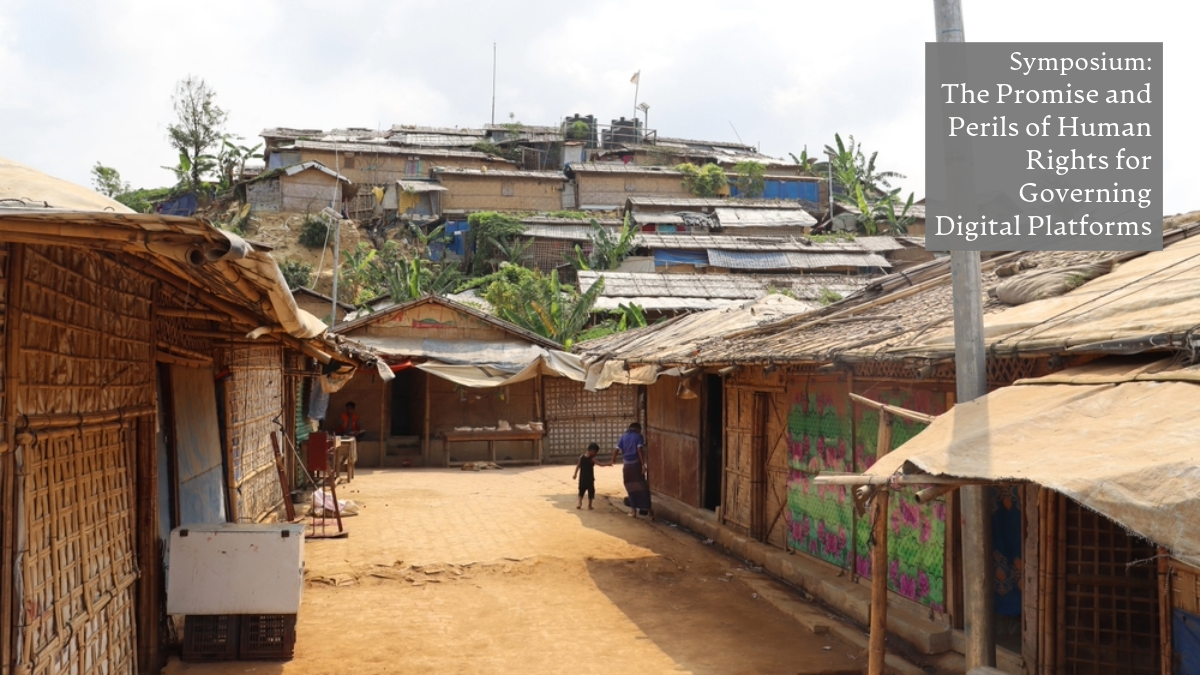Rethinking Digital Humanitarianism in Rohingya Refugee Camps
Suruchi Mazumdar / Jun 28, 2024This essay is part of a symposium on the promise and perils of human rights for governing digital platforms. Read more from the series here; new posts will appear between June 18 - June 30, 2024.

April 13, 2024: Rohingya camp in Kutupalong, Teknaf, Bangladesh. Aronno Rajib/Shutterstock
In 2018, the United Nations High Commissioner for Refugees (UNHCR), in association with the local government, introduced biometric registration for 1.2 million Rohingya refugees residing in Bangladeshi camps. But the encamped population — across the social spectrum from secularists to imams, female NGO workers to the marginalized female population — refused the ID cards amid massive protests organized by civil society groups from the community.
The Rohingya community already faced discrimination and was made stateless through changes in citizenship laws in their home country. In 2017, this Muslim population was subject to a genocide and was displaced both within and outside the national borders of Myanmar. While the largest exiled groups are currently settled in Kutupalong and Nayapara refugee camps in the Cox Bazar region of Bangladesh, the community also remains scattered across India, Malaysia, Thailand, and Australia, among other countries. The new “smart card” promised protection by using refugees’ “fingerprints, photographs, and iris scans,” but Rohingya community members saw biometric registration as a coercive measure that would prevent them from “passing” as Bangladeshis that would take away the opportunity to live outside concentration camps, as observed by anthropologist Elliott Prasse-Freeman.
This case offers an insight into the tension between the “helper” and the “helped” surrounding the employment of data-driven technology in humanitarian efforts, and draws attention to the critiques of the biometric identification that is increasingly used as the tool for emergency support and refugee management. The widespread use of digital platforms and technologies – such as biometric smart cards and drones, widely used across refugee settlements – evokes concerns of potential human rights violations by state and private actors and foregrounds the classic security-versus-rights dilemma. This brief intervention makes a call to re-conceptualize digital humanitarianism by recentering the affective, cultural, and creative labor of marginalized Rohingya refugee content creators in the light of their complex relationship with international humanitarian agencies. This initiative allows the opportunity to expand the scope of data justice beyond privacy debates to include bottom-up digital narratives and practices.
Limits of Humanitarian Technology
The digital footprint of a growing Rohingya diaspora started to expand with the pandemic. In the years since, the diaspora network proliferated, especially since the genocide of 2017, with considerable online imprints. While Rohingya refugees resisted the biometric identification system imposed by the UNHCR, international humanitarian organizations such as UNICEF and the BBC Media Action Plan remained active in the digital public sphere, complementing the digital practices of independent Rohingya digital content creators in Bangladesh’s refugee camps.
Technological innovation, aided by the spread and expansion of digital platforms as well as geospatial technologies and Web3 platforms, have redefined humanitarian operations in recent decades. Vast amounts of data generated with the digital labor of distributed populations redefined notions of speed, efficiency, and the impact of humanitarian efforts. The uses of mobile phones, social media platforms, geospatial technologies and various forms of crowdsourcing fundamentally altered how humanitarian crises are detected and addressed, and how information is collected, analyzed, and disseminated. There remains considerable optimism regarding the perceived benefits of the use of technology in humanitarian efforts. Biometric identification technologies instituted by the UNHCR and multiple national governments are seen as effective tools for emergency support and refugee management, identifying frauds and streamlining aid.
Such techno-optimism ignores critiques of “philanthrocapitalism” or the adaptation of private sector logics and rationalities to humanitarian efforts. For instance, the process of carving out the Rohingya digital identity involved public-private alliances between humanitarian agencies, the state, and the private sector. The biometric profiles of potential applicants are checked against an entire refugee database through algorithmic sorting. This assemblage of technologies such as AI and blockchain often necessitates state-private collaboration and generates huge profit for private actors.
It remains pertinent that the biometric technology industry originated in the prison-industrial complex of the United States in the mid-to-late 20th century and boomed in the post-9/11 era. A report published by The Engine Room, a multi-country research project exploring local communities’ “lived experiences” of digital ID systems introduced by local governments and humanitarian agencies, narrated Rohingya refugees’ suspicions that their biometric data would be shared with the national government in Myanmar for repatriation, given the Bangladesh government’s attempt at repatriation failed in the past. The suspicions stem from limited shared understanding of the purpose or utility of digital ID among actors, administrators, and users. The refugee population in the Bangladesh camps resisted biometric registration as the smart cards failed to identify them as Rohingyas. This was seen as the denial of recognition of their ethnic identity. While existing literature points to existing biometric technology’s inadequacies in identifying the iris and fingerprint scans of diverse racial groups, the Rohingya experience also highlighted the challenges of the lack of respect towards cultural norms during the registration process, as women were asked to remove headscarves.
This case indicates the lack of convergence between the goals of a marginalized, exiled population and a humanitarian agency’s attempt to use technology in refugee management. On one hand, Rohingya refugees resisted the Bangladesh governments’ efforts of repatriation, and the fear of repatriation remained pertinent in the initial resistance to the biometric identification process. On the other hand, refugee digital content creators made use of social media platforms and digital creative practices to reimagine a “digital homeland.”
Rethinking Data Justice
In my ongoing digital ethnographic project, multiple digital videos, created by Rohingya refugee content creators, articulated the yearning to return to an imagined homeland. The impulses of enjoyment and affect complemented the humanitarian goals of technology. One digital content creator, for instance, made a video series called “Dadir kissa” (Grandmother’s stories) in association with the BBC Media Action Project, which narrated Rohingya folktales through animation and visual storytelling. Animated folk stories or grandmothers’ tales acted as the narrative strategy to preserve the memory of a grandmother whom the male content creator left behind in Myanmar and establish digitally connected family or kinship beyond biological ties.
Apart from emotional registers, refugee content creators in digital videos address issues such as intimate partner violence, the malpractice of dowry, and nutritional benefits for lactating mothers, with the support of international charities such as BBC Media Action Plan. Digital videos, created by Rohingya digital content creators, act as a bottom-up medium to draw attention to the genocide by the Burmese military and challenge the official Burmese narrative. At the same time Rohingya digital content creators, as exemplified in their viral videos, wanted to return to the same homeland, where they faced social ostracism, loss of family, friends, and community to genocidal action. Multiple digital videos, for instance, displayed the national flag of Myanmar as the symbol of overt nationalism.
Over the past few years, the digital participation of Rohingya refugees grew despite challenging living conditions in makeshift refugee camps, their undocumented legal status, and mobility restrictions in host countries. The persecution of the Rohingya population has garnered international awareness as the geographically scattered diasporic population drew attention to their plight through increased social media participation. Rohingya digital content creators in the refugee camps remain attached to creative practices despite the challenges of precarity and refugee life. Creative aspirations, afforded by platforms, became a way to assert the collective self-esteem of the community.
While humanitarian agencies such as the BBC Media Action Plan address challenges of camp life through audio podcasts and visual storytelling and addressed issues such as violence against women, digital content creators also made “funny videos” to draw attention to poverty and the persecution of camp life or took resort to nostalgia to evoke the memory of the homeland. Such digital creative practices that flourished over and beyond the purview of international humanitarian agencies show the complex overlap between what is considered “silly” and what is perceived as political. The aspirational creative practices of Rohingya digital content creators, supported by digital affordances and the community’s growing digital participation, complement as well as preside over and beyond the purview of top-down humanitarian efforts. These affective digital creative practices contribute to an imagined digital homeland, whereas the digital identity-making process via data-driven biometric technologies, as instituted by humanitarian agencies with local governments of host countries, remains wrought with tension. This calls for the reimagination of the contours of data justice with bottom-up digital practices.
Authors
